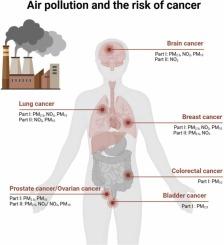Ambient air pollution and the risk of cancer: evidence from global cohort studies and epigenetic-related causal inference
IF 12.2
1区 环境科学与生态学
Q1 ENGINEERING, ENVIRONMENTAL
引用次数: 0
Abstract
The correlation between air pollution and cancer incidence has been a longstanding concern, understanding the need to elucidate the specifics of this relationship. Thus, this study aimed to assess the association between exposure to air pollution and cancer incidence, and to identify the possible biological links between the two. We examined global cohort studies investigating the association between air pollution and cancer and performed a univariate Mendelian randomization (MR) analysis. Our analysis revealed that the presence of particulate matter (PM)2.5, PM10, NO2, and NOx substantially impacted the risk of developing cancer. MR analysis identified 130 CpGs sites associated with three ambient air pollutants that have significant casual effects on the risk of 14 cancer sites (false discovery rate<0.05). Gene annotation was conducted using g-Profiler by screening for single nucleotide polymorphisms significantly associated with outcome, followed by analysis of the gene interaction network using GeneMANIA, and visualization using igraph. In conclusion, this study demonstrates that air pollution has a significant impact on cancer incidence, provides strong evidence for an epigenetic causal link between the two, and provides new insights into the molecular mechanisms by which air pollution affects cancer development.

求助全文
约1分钟内获得全文
求助全文
来源期刊

Journal of Hazardous Materials
工程技术-工程:环境
CiteScore
25.40
自引率
5.90%
发文量
3059
审稿时长
58 days
期刊介绍:
The Journal of Hazardous Materials serves as a global platform for promoting cutting-edge research in the field of Environmental Science and Engineering. Our publication features a wide range of articles, including full-length research papers, review articles, and perspectives, with the aim of enhancing our understanding of the dangers and risks associated with various materials concerning public health and the environment. It is important to note that the term "environmental contaminants" refers specifically to substances that pose hazardous effects through contamination, while excluding those that do not have such impacts on the environment or human health. Moreover, we emphasize the distinction between wastes and hazardous materials in order to provide further clarity on the scope of the journal. We have a keen interest in exploring specific compounds and microbial agents that have adverse effects on the environment.
 求助内容:
求助内容: 应助结果提醒方式:
应助结果提醒方式:


